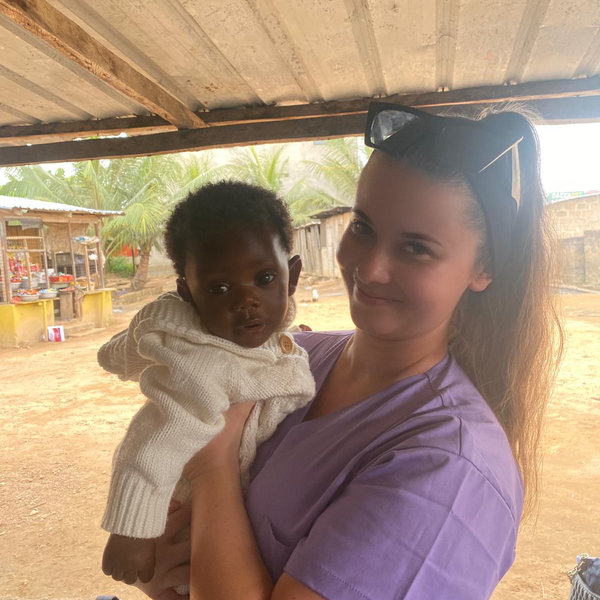Dundee University 2017
I chose Kandy in Sri Lanka for my Work the World placement as I had a friend who visited the city and said it was a really special place. I knew it was a safe city, and had already heard lovely things about the people who live there, including how friendly they were! I did some research into the area before booking, and there were a lot of really beautiful places to travel to. Plus, Kandy is quite small, and as I was only there for four weeks, it felt like I could get a really good taste for the area in that time.

When I got to the airport, Nandika, the Programme Manager, came to collect me. Along with the other students who arrived at the same time as me, we stayed overnight in a nearby hotel. The next day, we drove back to the Work the World house, and when we arrived, everyone was sat at the dinner table waiting for us! We felt so welcome, and everyone got chatting over dinner and some drinks, it was a really nice start to my time there. I never felt uncomfortable or homesick, and it made a huge difference meeting people who were there for the same reason as me — there were nurses, medics and a physio student.
The house was great; there was a communal area where we would hang out together after placement, as well as a big dining room and another lounge with couches downstairs. There was always someone in the house to chat to or hang out with, no matter what time of day!
The rooms were simple but perfect for crashing in after a busy day. There’s no air conditioning, so sometimes it’s a bit humid, but you get used to it — you just have to rip the covers off at night!
The food was amazing, it might have been my favourite thing about the house! Shen was the chef and he made amazing meals for us all, and there was always lots of food to help ourselves to in the fridge. On our first day we had a BBQ on the beautiful rooftop and there were lights and music, and we’d all have a drink together. It was a great way to get to know the other students that were there, regardless of where they had come from or what discipline they were studying. We all got along so well. I learnt a lot from the other students because some of the medics and nurses were in the year above or more experienced than me. There were lots of different nationalities there, and it was really beneficial to learn about healthcare in other countries, too.

Every weekend I did a trip with some of my new friends. We visited the Cultural Triangle, saw lots of ancient ruins, and even climbed to the top of the Sigiriya Rock Fortress. Nandika gave us a few tips when we were planning our trip, which was really useful.
The placement itself was really well supported. We got a tour of the hospital on the first day where we were taken to the ward to meet the ward sister. It was always the case that before started a new shift pattern I was taken to the ward office to be introduced to the staff on that shift. I never felt lost or alone.
There was a bit of a language barrier, but it was definitely manageable with observation. If you want to get involved, you have to be proactive, and show you’re willing. Whilst I was there, I got to assist with IVs, change dressings, and even observe in theatre. If you tell the nurses what you want to do they will do their best to help you. For example, although I’m a nurse not a midwife, I really wanted to see a labour, so every time a baby was being born the midwives came to grab me so I could observe!

The biggest difference was the lack of resources. For example, the way blood was taken was different — at home we have a vax, but they draw up the blood instead, something I wasn’t used to. I felt like it was a bit more old-fashioned. Another obvious difference was that doctors were seen as very ‘high up’ and nurses as very junior. There was definitely a hierarchy in place; but patients receive excellent care all the same.
One case I saw a lot of was dengue fever. When I was on General Medicine, there were a lot of patients with dengue fever, and they were all wrapped up in mosquito nets in their bed so that no mosquitoes could bite them and pass on the disease further. There was a lot of general observation on these patients as they had such high temperatures. I also saw a lot of dermatology patients, which was not what I was used to. The way they did dressings was different, too. It seemed old-fashioned, as they had to sterilise tools after use by boiling them. A lot of skin conditions came as a result of typhoid, where the wound that causes a bacteria that I’d never seen before.

I definitely learnt a lot whilst I was in the hospital — not just medical practises, but a lot about interpersonal communication. Even though I couldn’t speak the language particularly well, I improved my non-verbal communication so much and it became invaluable to my time there, dealing with patients and other members of staff.
If I could say one thing to other nurses or healthcare students thinking of travelling with Work the World, I’d say go for it! It was the best thing I’ve ever done, and I wish I could go back and do it all over again. I met some friends for life and came back with so much more appreciation for the healthcare system we have back at home.
.jpg)







